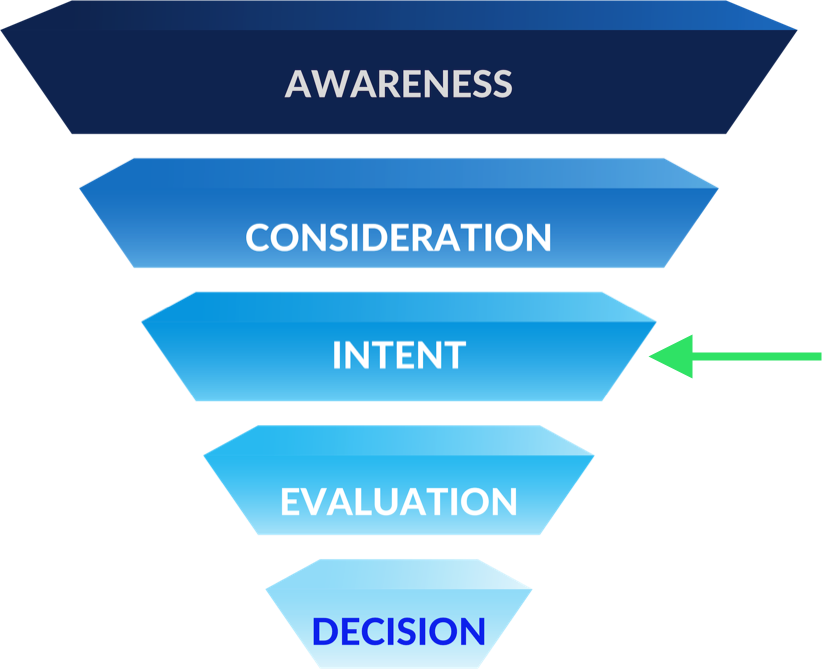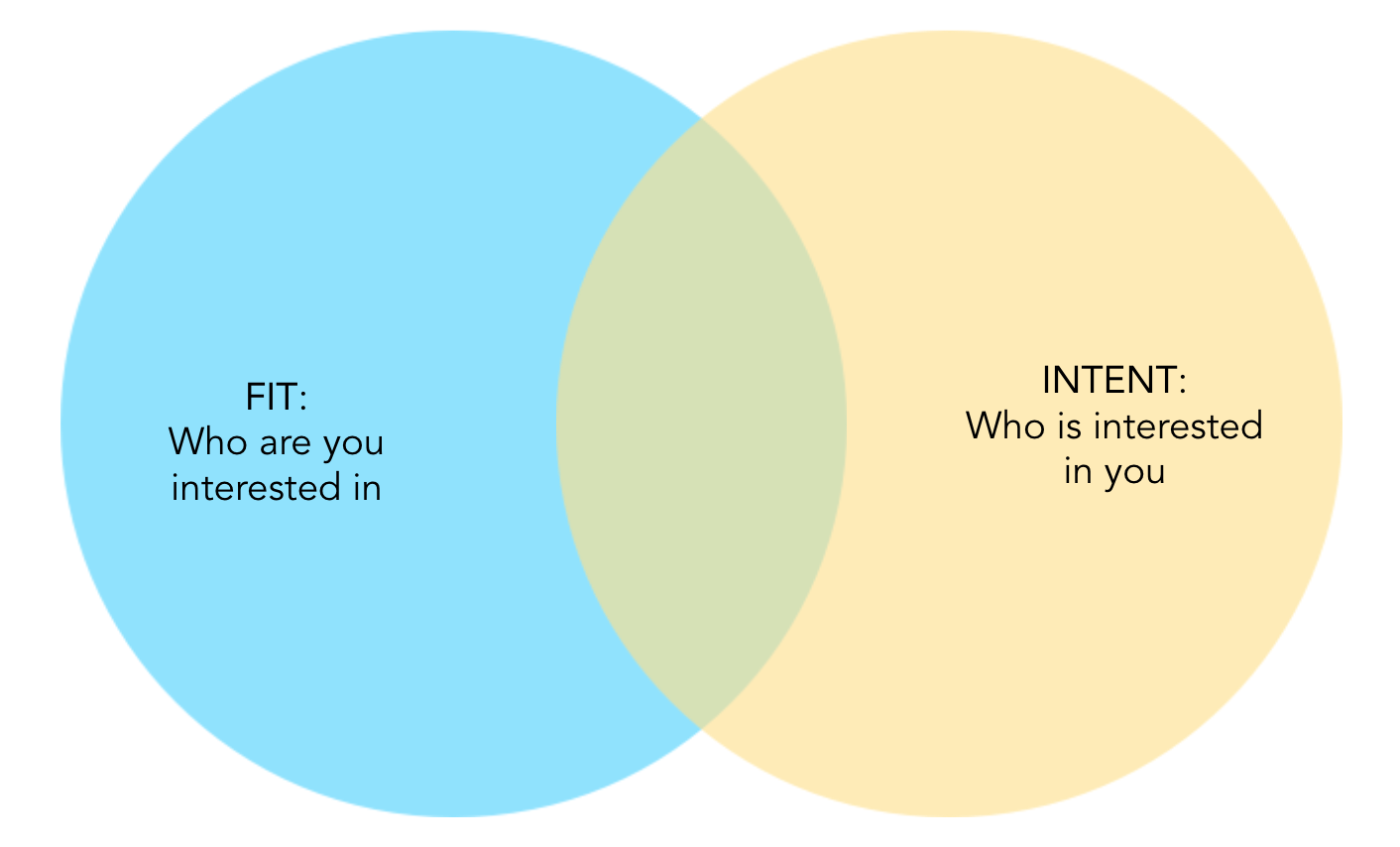How to use intent data to personalize B2B sales
[UPDATED] Originally posted on July 10, 2019.
Did you know you can use intent data to recognize high-quality leads who are likely to buy? You can do this by looking at the signals visitors leave when they browse your website. Whether visitors leave signals of purchase intent or signals that they need more information, intent data can provide extremely valuable insight for sales and marketing teams alike.

Spot the invisible leads
With a tool like Clearbit Reveal, which identifies a prospect’s company by IP addresses, you can de-anonymize your traffic. This allows your sales team to uncover leads that would otherwise go undetected. Instead of letting these invisible leads go cold while waiting for them to reach out to you, your sales reps can use B2B intent data to connect with ready-to-buy prospects higher up in the buyer’s journey.
For many organizations intent data is already built into their B2B marketing strategy. Intent data is the backbone of lead scoring models; they track typical B2B lead activities, like demo request forms, free trial sign-ups, and emails with the sales team.
However, all the above sources require prospects to make the first move by providing their email. In fact, that’s how you know who these high-intent prospects are.
But, what about those leads who haven’t filled out a form and aren’t yet in your CRM or marketing automation platform? An organization might be interested in buying from your business but want to do more research before reaching out for more information.
Interpreting the intent data from your website traffic can help you cater to these types of leads. Prospects with high intent may not immediately introduce themselves, but they leave signals they’re interested.
For example, an organization might notice stakeholders from a net-new account visit the pricing page five times in a week. If the following week they also view the product demo page and browse implementation docs, you know they are moving past the consideration phase into the intent phase. Once you’ve determined which invisible leads are in the intent phase, you can determine whether they’re a good match for you.
Filter matches based on ideal customer profiles
Intent data is great on its own for helping a B2B company determine who is interested in becoming a customer, but by comparing them to your ideal customer profile (ICP), you can easily pinpoint which leads are worth the sales team’s time.
Pursuing every opportunity equally, regardless of how compatible they are, doesn’t benefit you or your prospects. Your sales efforts should align with product-market fit. In other words, there’s no point in selling to a small business if you know your product is built for enterprises.
Pair your ICP with intent data for the best matches: highly interested prospects who have a high chance of experiencing value as a customer.

Let's say you have a list of target accounts you’re pursuing, a subset of Fortune 1000 companies. You see that people from Oracle have browsed your homepage, solutions page, and pricing page multiple times in the past two weeks. So, you know you can pursue the Oracle account with more gusto. And when jane@oracle.com signs up for one of your general newsletters (typically a relatively weak sign of purchase intent) and her job title fits your buyer personas, you know you can launch right into a more specific sales pitch and middle- to bottom-of-the-funnel content.
Alternatively, if someone comes in and reads multiple blog posts, chats up a storm on your chat tool, and visits that all-important pricing page 3 times? Those are all great behavioral signals in a B2B buyer, but if you know these visitors come from a 10-person startup with revenue well below your average customer, it would be a waste to invest so much time in a company that is likely not going to purchase or at best renew.
Using the quality filter of matching fit and intent focuses the efforts of your sales and marketing teams on the leads most likely to buy and get value from your product. And it gives you the data you need to be able to tailor the buying experience to maximize conversions. With proactive outreach from your sales team, you can deliver research support earlier in the buyer journey, along with a personalized marketing approach.
Refine your sales strategy based on lead behavior
By using intent data to find new leads and determine your best ICP matches, you can tailor your sales and marketing strategy to what best serves your potential customers.
Start by breaking leads down into two broad categories: bee-liner and browser. A bee-liner moves fast, while a browser wants time and space to make a decision. This distinction will determine how you cultivate these leads. Treat a bee-liner with urgency and give a browser plenty of time to make its decisions.
Bee-liners want you to match their speed
A bee-liner will leave plenty of signals they’re interested in buying from you in a short period of time. You might see an employee of a bee-liner company sign up for a webinar on the same day that three other employees visit your integrations page, where one of them downloads a whitepaper and another signs up for a free trial. That’s an indication that you have a bee-liner. This company is ready to make a decision. They’ll make it quickly and want to get up and running just as fast.
Provide these prospects with plenty of information and respond to their emails quickly. This potential customer needs to know you can move as fast as they can. They want a sales team who’s proactive and eager to make them happy. Show interest in them and make them feel special.
Browsers want time and space to decide
At the other extreme is the browser. You might see an employee of a browser company visit your webpage one week. Then a week later, another employee looks through implementation logs and downloads a few case studies. Another week goes by, and a third employee signs up for a demo. You’ve got a browser on your hands.
This is the kind of lead that should be nurtured but not rushed. Their intent signals indicate that they are clearly interested in what you have to offer but aren’t moving as quickly as a bee-liner.
Once you identify from your intent data that you have a browser, approach them casually. You don’t want to overwhelm them with product information or questions. You might email them once with a trial extension offer and the best ways to get in contact for a demo walkthrough. But it should be a warm welcome with an open invitation for more interaction when they’re ready — no deadlines or questions about their timeline. They’ll appreciate not feeling rushed, and when they’re done with online research and ready to buy, you’ll likely have a happy new customer who knows you respect their time.
If you’re interested in personalizing your B2B sales approach to bee-liners and browsers, check out our guide on how to use intent data.
